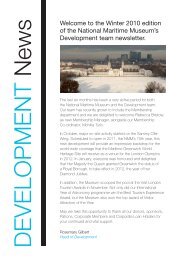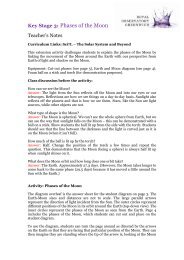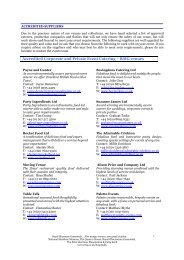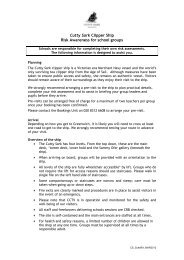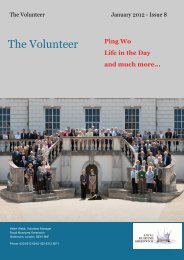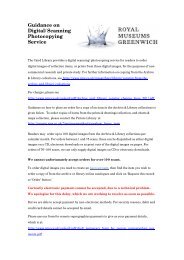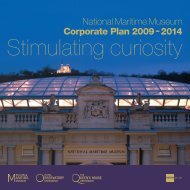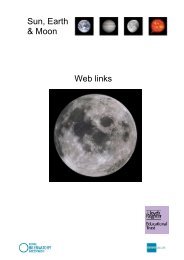Story building on board Cutty Sark - National Maritime Museum
Story building on board Cutty Sark - National Maritime Museum
Story building on board Cutty Sark - National Maritime Museum
Create successful ePaper yourself
Turn your PDF publications into a flip-book with our unique Google optimized e-Paper software.
TEACHERS’ NOTES<br />
KS2 LITERACY – SELF DIRECTED SUPPORT MATERIALS<br />
© Nati<strong>on</strong>al <strong>Maritime</strong> <strong>Museum</strong><br />
KS2 LITERACY - SELF-DRIECTED SUPPORT MATERIALS<br />
<str<strong>on</strong>g>Story</str<strong>on</strong>g> <str<strong>on</strong>g>building</str<strong>on</strong>g> <strong>on</strong> <strong>board</strong> <strong>Cutty</strong> <strong>Sark</strong><br />
© <strong>Cutty</strong> <strong>Sark</strong> Trust, 2012
TEACHERS’ NOTES<br />
Ks2 LITERACY ACTIVITIES<br />
<str<strong>on</strong>g>Story</str<strong>on</strong>g> <str<strong>on</strong>g>building</str<strong>on</strong>g> <strong>on</strong> <strong>board</strong> <strong>Cutty</strong> <strong>Sark</strong><br />
Table of c<strong>on</strong>tents<br />
How to use this resource ...................................... 2<br />
Curriculum links .................................................. 3<br />
Pre-visit activities ................................................ 4<br />
On-<strong>board</strong> activities: group leader instructi<strong>on</strong>s.... 5<br />
Classroom resources .......................................... 12<br />
Page 1<br />
© <strong>Cutty</strong> <strong>Sark</strong> Trust, 2012
TEACHERS’ NOTES<br />
Ks2 LITERACY ACTIVITIES<br />
<str<strong>on</strong>g>Story</str<strong>on</strong>g> <str<strong>on</strong>g>building</str<strong>on</strong>g> <strong>on</strong> <strong>board</strong> <strong>Cutty</strong> <strong>Sark</strong><br />
How to use this resource<br />
Introducti<strong>on</strong><br />
This pack c<strong>on</strong>tains teachers’ notes, pre-visit<br />
activities and instructi<strong>on</strong>s for <strong>on</strong>-<strong>board</strong><br />
activities to support self-directed literacy<br />
visits to <strong>Cutty</strong> <strong>Sark</strong>.<br />
Activities focus <strong>on</strong> developing imaginati<strong>on</strong><br />
and story-<str<strong>on</strong>g>building</str<strong>on</strong>g> skills. They are intended<br />
to help your pupils collect ideas and<br />
informati<strong>on</strong> which can be used to inspire<br />
creative writing back in the classroom.<br />
The activities are designed to be flexible and<br />
adaptable for the needs of your group.<br />
Depending <strong>on</strong> the year group you’re working<br />
with and units you are studying you could use<br />
them as inspirati<strong>on</strong> for writing:<br />
a story about a journey at sea<br />
a mystery<br />
an adventure<br />
a legend<br />
a play<br />
a story in a historical setting or with a<br />
particular genre<br />
We recommend splitting your<br />
class into small groups to complete<br />
the activities and providing adult<br />
helpers with instructi<strong>on</strong>s and / or<br />
copies of the activities in advance<br />
of your visit.<br />
Activities<br />
There are 7 activities to choose from – work<br />
sheets are available to download separately.<br />
You will need to:<br />
1. plan how to tie your visit in with<br />
literacy work in the classroom (see<br />
below for suggested pre-visit<br />
activities)<br />
2. select which activities you would like<br />
your class to focus <strong>on</strong> (there is no<br />
particular order to follow – we<br />
recommend choosing up to 4)<br />
3. use the activity sheets provided, OR<br />
use an instructi<strong>on</strong> sheet and your own<br />
recording methods for each activity<br />
(e.g. log books, photographs) *<br />
4. follow up your visit with creative<br />
writing activities in the classroom<br />
*Work sheets are available to download<br />
separately as pdf’s or editable Word<br />
documents.<br />
Instructi<strong>on</strong>s for group leaders are in this<br />
pack. They include suggested introducti<strong>on</strong>s<br />
and extensi<strong>on</strong> activities. The can be used with<br />
or without the work sheets.<br />
Children must be supervised<br />
by an adult at all times.<br />
Page 2<br />
© <strong>Cutty</strong> <strong>Sark</strong> Trust, 2012
TEACHERS’ NOTES<br />
Ks2 LITERACY ACTIVITIES<br />
<str<strong>on</strong>g>Story</str<strong>on</strong>g> <str<strong>on</strong>g>building</str<strong>on</strong>g> <strong>on</strong> <strong>board</strong> <strong>Cutty</strong> <strong>Sark</strong><br />
Curriculum links<br />
KS2 Literacy<br />
Year 3 – Adventure and Mystery Narratives<br />
Write a first pers<strong>on</strong> account<br />
Plan by plotting a sequence of episodes<br />
Identify a problem, events and resoluti<strong>on</strong><br />
Recount an incident in a different way<br />
Year 4 – Stories with hi storical settings<br />
Build character and setting from details<br />
Mapping chr<strong>on</strong>ology<br />
Plan a story<br />
Year 5 – Traditi<strong>on</strong>al stories, fables, myths<br />
and legends & Dramatic c<strong>on</strong>venti<strong>on</strong>s<br />
Empathise with characters through drama<br />
Work collaboratively to write a legend<br />
Script writing<br />
Year 6 – Ficti<strong>on</strong> genres & Short stories with<br />
flashbacks<br />
Narrative structure<br />
Genre as a model for writing<br />
Write own story using flashbacks or a<br />
story within a story<br />
Cross-curricular links<br />
KS2 Geography<br />
KS2 History<br />
to use atlases and globes, and maps and<br />
plans at a range of scales<br />
to use appropriate geographical<br />
vocabulary<br />
to identify and describe what places are<br />
like<br />
to recognise how places fit within a wider<br />
geographical c<strong>on</strong>text and are<br />
interdependent<br />
characteristic features of the periods and<br />
societies studied, including the ideas,<br />
beliefs, attitudes and experiences of men,<br />
women and children in the past<br />
how to find out about the events, people<br />
and changes studied from an appropriate<br />
range of sources of informati<strong>on</strong>, including<br />
ICT-based sources<br />
communicate their knowledge and<br />
understanding of history in a variety of<br />
ways<br />
A study of the impact of significant<br />
individuals, events and changes in work<br />
and transport <strong>on</strong> the lives of men, women<br />
and children from different secti<strong>on</strong>s of<br />
society.<br />
Page 3<br />
© <strong>Cutty</strong> <strong>Sark</strong> Trust, 2012
TEACHERS’ NOTES<br />
Ks2 LITERACY ACTIVITIES<br />
<str<strong>on</strong>g>Story</str<strong>on</strong>g> <str<strong>on</strong>g>building</str<strong>on</strong>g> <strong>on</strong> <strong>board</strong> <strong>Cutty</strong> <strong>Sark</strong><br />
Pre-visit activities<br />
A sailor’s life<br />
With your class, look the accounts<br />
written by two apprentices <strong>on</strong> <strong>Cutty</strong><br />
<strong>Sark</strong>*.<br />
You could:<br />
a) Identify key characters, style of<br />
writing, narrative voice, and use of<br />
descriptive language. Discuss which<br />
writer you have learnt the most<br />
about as a character.<br />
b) Record any unfamiliar words in the<br />
text, look them up and use them to<br />
create a beginners guide to sailor’s<br />
language (http://www.seatalk.info<br />
is a useful resource)<br />
c) Try re-writing the accounts in a<br />
different style, as a letter, play or<br />
story and/or completing Purssey<br />
Phillip’s journey around Cape Horn,<br />
maintaining dramatic suspense.<br />
Log books<br />
Make log books to bring when you visit<br />
to record story ideas (exercise books<br />
were used for <strong>Cutty</strong> <strong>Sark</strong>’s logs).<br />
You could cut and stick secti<strong>on</strong>s from<br />
the work sheets into your books, or<br />
make the sheets into books with card<br />
covers.<br />
Character <str<strong>on</strong>g>building</str<strong>on</strong>g><br />
Use the apprentices’ accounts below as<br />
inspirati<strong>on</strong> for developing characters.<br />
Use the table* to record details<br />
of Captain Woodget’s and/or<br />
C.E. Ray’s characters.<br />
Think of 4 questi<strong>on</strong>s to ask each<br />
character to find out more about<br />
them.<br />
Get students to create their own<br />
characters.<br />
Use the crew list for ideas. Who<br />
will be the hero? An apprentice?<br />
The cook? The captain? A<br />
stowaway?<br />
Use the table again to create a<br />
profile.<br />
*Support materials are at<br />
the back of this pack – see<br />
classroom resources.<br />
Find out more about <strong>Cutty</strong><br />
<strong>Sark</strong>’s history at<br />
www.rmg.co.uk/cuttysark<br />
Page 4<br />
© <strong>Cutty</strong> <strong>Sark</strong> Trust, 2012
TEACHERS’ NOTES<br />
Ks2 LITERACY ACTIVITIES<br />
<str<strong>on</strong>g>Story</str<strong>on</strong>g> <str<strong>on</strong>g>building</str<strong>on</strong>g> <strong>on</strong> <strong>board</strong> <strong>Cutty</strong> <strong>Sark</strong><br />
On-<strong>board</strong> activities: group leader instructi<strong>on</strong>s<br />
Activity 1: Setting the scene for your story<br />
Where is it?<br />
This activity will help develop vocabulary and descriptive language<br />
for a story. It will be particularly helpful for stories in historic<br />
settings.<br />
Locati<strong>on</strong>: Around the ship (start at Lower Hold or Main Deck)<br />
Introducti<strong>on</strong><br />
There are lots of interesting names for things <strong>on</strong> ships which will<br />
help you to describe places in your story.<br />
Let’s see how many we can find!<br />
Instructi<strong>on</strong>s<br />
1. As we go around the ship, look out for the names of the<br />
different parts of the ship.<br />
2. Label each place <strong>on</strong> your ship picture write a descripti<strong>on</strong><br />
for it (image of ship available <strong>on</strong> worksheet).<br />
Extensi<strong>on</strong><br />
Collect other nautical words to use in your story, for example:<br />
- bits of equipment – main deck or dry berth<br />
- materials the ship is made of – Lower Hold<br />
- names of types of tea – Lower hold<br />
- names of crew members – ’Tween deck<br />
Page 5<br />
© <strong>Cutty</strong> <strong>Sark</strong> Trust, 2012
TEACHERS’ NOTES<br />
Ks2 LITERACY ACTIVITIES<br />
<str<strong>on</strong>g>Story</str<strong>on</strong>g> <str<strong>on</strong>g>building</str<strong>on</strong>g> <strong>on</strong> <strong>board</strong> <strong>Cutty</strong> <strong>Sark</strong><br />
On-<strong>board</strong> activities: group leader instructi<strong>on</strong>s<br />
Activity 2: Your journey<br />
Where will you go in your story?<br />
This activity focuses <strong>on</strong> time, place and sequencing in stories and also draws <strong>on</strong><br />
geographical skills.<br />
Locati<strong>on</strong>: ’Tween deck – start at the globe (bow end of the ship).<br />
Introducti<strong>on</strong><br />
<strong>Cutty</strong> <strong>Sark</strong> sailed to every major port in the world. Let’s look at 2 of her journeys<br />
then think about where you would like to sail to in your story.<br />
Instructi<strong>on</strong>s<br />
1. Look at the globe - which countries is <strong>Cutty</strong> <strong>Sark</strong> sailing back from?<br />
A: The globe shows <strong>Cutty</strong> <strong>Sark</strong>’s journeys from China and Australia,<br />
The red route shows <strong>Cutty</strong> <strong>Sark</strong>’s journey back from China, the Green shows<br />
her route from Australia.<br />
2. What was she carrying <strong>on</strong> the green route and the red route?<br />
A: wool and tea<br />
3. Where will you go <strong>on</strong> your journey? Mark it <strong>on</strong> your map*.<br />
Add:<br />
- something you would see <strong>on</strong> the way<br />
- a key to show temperatures and weather<br />
- how l<strong>on</strong>g the journey will take<br />
- what it will be like when you arrive<br />
*Map available <strong>on</strong> worksheet<br />
INFO:<br />
Fastest time China to L<strong>on</strong>d<strong>on</strong> = 109 days<br />
L<strong>on</strong>gest round trip from L<strong>on</strong>d<strong>on</strong> to New York = 771 days!<br />
Extensi<strong>on</strong><br />
<strong>Cutty</strong> <strong>Sark</strong> sailed to lots of countries to collect different cargoes.<br />
Find the cargoes touch screen or the map of the world.<br />
Where you would sail to for coal, rice, wood?<br />
Draw them <strong>on</strong> your map.<br />
Page 6<br />
© <strong>Cutty</strong> <strong>Sark</strong> Trust, 2012
TEACHERS’ NOTES<br />
Ks2 LITERACY ACTIVITIES<br />
<str<strong>on</strong>g>Story</str<strong>on</strong>g> <str<strong>on</strong>g>building</str<strong>on</strong>g> <strong>on</strong> <strong>board</strong> <strong>Cutty</strong> <strong>Sark</strong><br />
On-<strong>board</strong> activities: group leader instructi<strong>on</strong>s<br />
Activity 3: What is the problem in your story?<br />
Look out!<br />
This activity involves using imaginati<strong>on</strong> to resolve a problem and develop a<br />
simple dialogue. It could also involve role play as an extensi<strong>on</strong> activity.<br />
Locati<strong>on</strong>: Main Deck, Liverpool House (by the ship’s wheel)<br />
Introducti<strong>on</strong><br />
You have a very important job – you’re <strong>on</strong> ‘watch’. Look out for anything<br />
unusual or dangerous out at sea and report it to the ship’s Master (Captain).<br />
Instructi<strong>on</strong>s<br />
Think about where in the world you are and what the weather is like.<br />
1. Use your imaginati<strong>on</strong>s - you’re surrounded by sea. Look out at the<br />
water - what can you see? Is there anything strange, or scary, or<br />
dangerous?<br />
Record it <strong>on</strong> your sheets / log books.<br />
2. Go down the steps to the Master’s salo<strong>on</strong> to tell the Captain what you<br />
have seen. Look around and imagine where the Master might be<br />
sitting. Write down what you would tell him and how you think he<br />
would answer.<br />
Extensi<strong>on</strong><br />
Try acting out the scenarios as a mini role play.<br />
Page 7<br />
© <strong>Cutty</strong> <strong>Sark</strong> Trust, 2012
TEACHERS’ NOTES<br />
Ks2 LITERACY ACTIVITIES<br />
<str<strong>on</strong>g>Story</str<strong>on</strong>g> <str<strong>on</strong>g>building</str<strong>on</strong>g> <strong>on</strong> <strong>board</strong> <strong>Cutty</strong> <strong>Sark</strong><br />
On-<strong>board</strong> activities: group leader instructi<strong>on</strong>s<br />
Activity 4: What is the problem in your story?<br />
Something’s wr<strong>on</strong>g<br />
This activity involves basic role play and discussi<strong>on</strong> to help plan a story with a<br />
problem to resolve. In wet weather start <strong>on</strong> the Main Deck then move to the ’Tween<br />
Deck.<br />
Locati<strong>on</strong>: Main Deck, bow end (towards the river)<br />
Introducti<strong>on</strong><br />
The Main Deck is where sailors lived and worked. We are going to imagine we are<br />
sailors doing every day jobs - while we’re doing them, something will go wr<strong>on</strong>g. You<br />
will need to work out how to solve the problem.<br />
Instructi<strong>on</strong>s<br />
1. Find the pig pen, windlass & rigging<br />
2. Act out the jobs sailors would have d<strong>on</strong>e at each <strong>on</strong>e<br />
3. While you are acting, I (group leader) will call out FREEZE and give you a<br />
problem to discuss and solve<br />
4. Record your ideas <strong>on</strong> a story <strong>board</strong> (available <strong>on</strong> worksheet)<br />
NOTE – please do not allow children to actually climb the rigging of move any<br />
equipment!<br />
FREEZE! game<br />
For each activity, call out freeze then give a problem to solve<br />
Cleaning the pigs (pooey!)<br />
A pig escapes <strong>on</strong>to the deck...<br />
Pumping the windlass (is it hard work?)<br />
The anchor is stuck...<br />
Climbing the rigging (how high can you go?) Some<strong>on</strong>e falls over <strong>board</strong>...<br />
Extensi<strong>on</strong><br />
Think of other problems that could come up when doing a job.<br />
Look at the Galley, Carpenter’s workshop, equipment <strong>on</strong> the main deck, lifeboats etc. for<br />
ideas.<br />
Page 8<br />
© <strong>Cutty</strong> <strong>Sark</strong> Trust, 2012
TEACHERS’ NOTES<br />
Ks2 LITERACY ACTIVITIES<br />
<str<strong>on</strong>g>Story</str<strong>on</strong>g> <str<strong>on</strong>g>building</str<strong>on</strong>g> <strong>on</strong> <strong>board</strong> <strong>Cutty</strong> <strong>Sark</strong><br />
On-<strong>board</strong> activities: group leader instructi<strong>on</strong>s<br />
Activity 5: Something strange in your story<br />
Strange things in the night<br />
This activity is about setting the scene for something strange to happen<br />
at night, which could form part of a mystery or adventure story.<br />
Locati<strong>on</strong>: Main Deck, Forward Deckhouse<br />
Introducti<strong>on</strong><br />
This is where sailors used to sleep, eat and keep their bel<strong>on</strong>gings.<br />
Instructi<strong>on</strong>s<br />
1. Count the bunks - how many sailors slept here?<br />
2. Which bunk would you choose? Discuss what it would have<br />
been like. Would they have slept well? What might they have<br />
dreamt about?<br />
3. Imagine you are in your bunks – what sounds can you hear?<br />
4. Complete these sentences to create a very short story:<br />
‘I was asleep in my bunk when…’<br />
‘I leapt out of bed and…’<br />
‘in the end…’<br />
Extensi<strong>on</strong><br />
1. Create a ‘<strong>on</strong>e word’ story. The first pers<strong>on</strong> starts by saying:<br />
‘I was asleep in my bunk when suddenly...’ the next pers<strong>on</strong> adds a word, and<br />
the next, <strong>on</strong>e word at a time as quickly possible to make a story.<br />
2. If you have time, go to the fo’c’sle <strong>on</strong> the ’Tween deck too (the small<br />
space at the bow end of the ship). This is where sailors slept before 1872.<br />
How many sailors had bunks here? ( hint: look up, the number is<br />
stamped <strong>on</strong> the beam to the right of the ladder as you go in)<br />
How did sailors got to the main deck?<br />
Page 9<br />
© <strong>Cutty</strong> <strong>Sark</strong> Trust, 2012
TEACHERS’ NOTES<br />
Ks2 LITERACY ACTIVITIES<br />
<str<strong>on</strong>g>Story</str<strong>on</strong>g> <str<strong>on</strong>g>building</str<strong>on</strong>g> <strong>on</strong> <strong>board</strong> <strong>Cutty</strong> <strong>Sark</strong><br />
On-<strong>board</strong> activities: group leader instructi<strong>on</strong>s<br />
Activity 6: Find some details for your story<br />
Hobbies, food and cargo<br />
This activity will help children find details to add to their stories to give them<br />
interest or historic c<strong>on</strong>text.<br />
Locati<strong>on</strong>: ’Tween deck – towards the stern<br />
Introducti<strong>on</strong><br />
A good story has lots of details in it to help set the scene, describe characters, or<br />
create atmosphere. Let’s research some details about the crew and cargoes.<br />
Instructi<strong>on</strong>s (food)<br />
1. Look for the food drawers (next to touch screens – 4 drawers in total)<br />
2. Discuss and record the types of food sailors ate.<br />
3. Would you like them? Why / why not?<br />
Instructi<strong>on</strong>s (hobbies)<br />
1. Look around for some of the hobbies the crew used to have (cycling,<br />
photography, woodwork, writing letters)<br />
2. Record what you find.<br />
3. Write down a hobby that you would choose to do <strong>on</strong> a ship.<br />
Instructi<strong>on</strong>s (cargoes & stowaways)<br />
1. Look at the cargoes map, crates and touch screens.<br />
2. Write down three cargoes that <strong>Cutty</strong> <strong>Sark</strong> carried<br />
3. Imagine you have found a stowaway hiding in the cargo. What would you<br />
do?<br />
Extensi<strong>on</strong><br />
Think of creative ways to describe the different foods / cargoes / hobbies you’ve found.<br />
In pairs, take turns to describe some of the different foods / cargoes / hobbies without<br />
saying what it actually is.<br />
Use these questi<strong>on</strong>s to help:<br />
What does it feel like?<br />
What does it sound like?<br />
What does it smell like?<br />
What does it taste like?<br />
What does it look like?<br />
Page 10<br />
© <strong>Cutty</strong> <strong>Sark</strong> Trust, 2012
TEACHERS’ NOTES<br />
Ks2 LITERACY ACTIVITIES<br />
<str<strong>on</strong>g>Story</str<strong>on</strong>g> <str<strong>on</strong>g>building</str<strong>on</strong>g> <strong>on</strong> <strong>board</strong> <strong>Cutty</strong> <strong>Sark</strong><br />
On-<strong>board</strong> activities: group leader instructi<strong>on</strong>s<br />
Activity 7: Interesting details for your story<br />
Figureheads<br />
This activity will help children find details or characters to add to their<br />
stories to make them pers<strong>on</strong>al or provide historic c<strong>on</strong>text.<br />
Locati<strong>on</strong>: Sammy Ofer Gallery (underneath the ship), by the<br />
figureheads<br />
Introducti<strong>on</strong><br />
Ships had figureheads for good luck, and to protect them <strong>on</strong> voyages.<br />
<strong>Cutty</strong> <strong>Sark</strong>’s figurehead, Nannie, is holding a horses’ tail – can you see her?<br />
Your story might have a figurehead in it too. Let’s look at these <strong>on</strong>es for<br />
ideas.<br />
Instructi<strong>on</strong>s<br />
1. Have a close look at the figureheads. Can you find and name:<br />
A Native American (A: Hiawatha)<br />
A king<br />
A famous nurse (A: Florence Nightingale)<br />
2. Choose a figurehead for your ship and complete these sentences:<br />
If I had a ship, the figurehead would be...<br />
because...<br />
Extensi<strong>on</strong><br />
Create a pose for your figurehead. Take picture if you have a camera.<br />
Watch the film about Nannie, <strong>Cutty</strong> <strong>Sark</strong>’s figurehead, in the Sammy Ofer<br />
Gallery (left of the figureheads)..<br />
Page 11<br />
© <strong>Cutty</strong> <strong>Sark</strong> Trust, 2012
TEACHERS’ NOTES<br />
Ks2 LITERACY ACTIVITIES<br />
<str<strong>on</strong>g>Story</str<strong>on</strong>g> <str<strong>on</strong>g>building</str<strong>on</strong>g> <strong>on</strong> <strong>board</strong> <strong>Cutty</strong> <strong>Sark</strong><br />
Classroom resources: apprentices’ accounts<br />
Descripti<strong>on</strong> of Captain Richard Woodget<br />
‘Two Milli<strong>on</strong> Miles <strong>on</strong> Salt Water’, Captain G. Purssey Phillips, 1939<br />
‘We spent Christmas in Sydney, in baking weather. Our deserters were all caught,<br />
and lodged in Newcastle Gaol till we sailed, when they were brought a<strong>board</strong>, silent,<br />
sullen and mutinous…<br />
Our cargo that trip was 4723 bales of wool…Loading wool cargo was a racing matter,<br />
ship against ship, for the first cargoes back to Europe commanded the highest<br />
prices…<br />
So our skipper, ir<strong>on</strong>-hearted Captain Woodget, most famous of <strong>Cutty</strong> <strong>Sark</strong>’s<br />
Captains, used to spend his whole time glowering in the hold, while she was loading,<br />
making sure that the stevedores crushed the last possible bale into her…<br />
Captain Woodget was the man to get cargo into her, and to make her fly, no matter<br />
what she had <strong>on</strong> a<strong>board</strong>. When Willis [her owner] gave him command he…pointed<br />
to the lovely clipper, riding light, and said: “There’s your ship. What you have to do<br />
is DRIVE HER!”<br />
And by God, he drove her! He drove his ship, he drove his crews, he never lost his<br />
ir<strong>on</strong> nerve; he took terrific risks, yet I believe he never lost a spar.<br />
I remember him, stumpy, grim, and powerful, biting his l<strong>on</strong>g moustache, clinging to<br />
the rigging like a troll of the storm, his oilskins, sea-boots, and sou’wester streaming,<br />
grinning like mad as <strong>Cutty</strong> <strong>Sark</strong> hissed al<strong>on</strong>g with her rail under, passing<br />
Thermopylae, Blackadder, Coral Nymph – holding <strong>on</strong> when no other of the hardbitten<br />
clipper captains dared to hold <strong>on</strong>, and winning rivals and his own swearing<br />
seamen alike the grudging tribute of the hardest, straightest, finest seamen who ever<br />
sailed’<br />
Page 12<br />
© <strong>Cutty</strong> <strong>Sark</strong> Trust, 2012
TEACHERS’ NOTES<br />
Ks2 LITERACY ACTIVITIES<br />
<str<strong>on</strong>g>Story</str<strong>on</strong>g> <str<strong>on</strong>g>building</str<strong>on</strong>g> <strong>on</strong> <strong>board</strong> <strong>Cutty</strong> <strong>Sark</strong><br />
Classroom resources: apprentices’ accounts<br />
A dramatic voyage around Cape Horn<br />
‘Two Milli<strong>on</strong> Miles <strong>on</strong> Salt Water’, Captain G. Purssey Phillips, 1939<br />
‘Once into the Pacific we met light headwinds …then the wind changed and we began<br />
to step al<strong>on</strong>g.<br />
Good weather did not last. Almost at <strong>on</strong>ce, an icy, clinging fog enveloped the ship.<br />
Sharp lookout was kept; and several gigantic icebergs were sighted, drifting past in<br />
giant processi<strong>on</strong>. It grew very cold-and we apprentices had reas<strong>on</strong> to know it,<br />
handling the <strong>board</strong>-stiff canvas with our broken nails. Sleet and snow whipped the<br />
ship steadily; and through the thick white flakes and the drifting spume we got<br />
terrifying glimpses of c<strong>on</strong>stant lines of bergs, standing high above our 150-feet<br />
topmast and completely dwarfing us, there sometimes thirty or more in sight <strong>on</strong><br />
each side at <strong>on</strong>ce…<br />
It was a weird experience, going to the top of the main mast into that clammy<br />
whiteness, sitting astride a yard yawning to and fro, unable to see <strong>on</strong>e’s own hands,<br />
and pressed in by a silence broken <strong>on</strong>ly the thunder of the seas <strong>on</strong> our hull, and the<br />
terrifying explosi<strong>on</strong>s and crackings …from icebergs shoving up beside us but quite<br />
invisible…<br />
As we drew near Cape Stiff we were struck by appalling gusts of sleet, like giants’<br />
swords of ice. The water gathered into colossal hills that slid and danced a drunken<br />
jig, their foaming crests higher than our masts…<br />
All the time, Skipper Woodget clung to the ropes and laughed…and presently, I<br />
caught a glimpse of the horn itself…standing out defiant of the bursting ocean…<br />
That stark picture remains vivid in my memory as if I had suddenly seen the end of<br />
the world. Presently, we were heading northward, and the weather abated to a southwest<br />
breeze, which swept us foaming al<strong>on</strong>g through a gathering white fog. I thought<br />
the worst was past – but it was still to come….’<br />
Page 13<br />
© <strong>Cutty</strong> <strong>Sark</strong> Trust, 2012
TEACHERS’ NOTES<br />
Ks2 LITERACY ACTIVITIES<br />
<str<strong>on</strong>g>Story</str<strong>on</strong>g> <str<strong>on</strong>g>building</str<strong>on</strong>g> <strong>on</strong> <strong>board</strong> <strong>Cutty</strong> <strong>Sark</strong><br />
Classroom resources: apprentices’ accounts<br />
A letter home from C.E. Ray, apprentice <strong>on</strong> <strong>board</strong> <strong>Cutty</strong> <strong>Sark</strong><br />
<strong>Cutty</strong> <strong>Sark</strong>, Brisbane<br />
My Dear Mother,<br />
We have arrived … safe and sound having made a passage of 80 days... I was very glad to<br />
hear that you enjoyed your holiday and also very sorry to hear of Mr. Els<strong>on</strong>’s accident.<br />
Now I suppose you want to know how I am. Well I am all right and getting a muscle <strong>on</strong><br />
me like a horse and you will be glad to hear that I have not had a day’s illness of any kind<br />
since I have been a<strong>board</strong> the ship. Not even a headache.<br />
Now I must tell you something about the Passage out. We had pretty fine weather down<br />
to the line, except in the Bay. …We got 3 or 4 days doldrums. Then came heavy squalls, I<br />
used to get wet every day then, I’ll go to the wheel with nothing <strong>on</strong> but pants and shirt<br />
and then a heavy squall would come and drown me but I’d have to stop the 2 hours wet<br />
or no wet.<br />
Then it began to get colder and colder till we got round the Corner (Cape of Good Hope)<br />
… Then was the time to wish you had never come to sea (if there are any boys in Hastings<br />
who want to come to sea, show them this and tell them from me to stop in a good home<br />
when they got <strong>on</strong>e) … One time …the cabin was washed out, our cuddy door was burst<br />
open (we saw this in the night, but no <strong>on</strong>e dare go <strong>on</strong> the main deck to shut it) all the<br />
lower bunks were washed out. Mine being a top <strong>on</strong>e did not suffer much, but all the<br />
things in my chest were more or less wet.<br />
The next Sunday the skipper’s s<strong>on</strong> got washed into the lee scuppers and broke his arm.<br />
He is going to have the splints off next week, the doctor says he is very lucky to have it<br />
set right at sea…<br />
I will finish this brief account in my next letter, for if I stop for much more I shall miss<br />
the mail. … My stores have lasted well I think. I ate the last piece of cake the day we<br />
crossed the Line (it was slightly hard) you can tell nurse that they were lovely.<br />
… I must knock off now so expect a l<strong>on</strong>g letter next mail from,<br />
Your loving<br />
Sailor boy<br />
C. E. Ray<br />
PS Tell Spot I am going to bring him some sea crackers home, and, if he gets outside of 3<br />
at <strong>on</strong>ce I will guarantee he will be a regular shellback. When I come home I will tell you<br />
everything, much better than I can write it.<br />
Please excuse all mistakes in spelling, and bad writing.<br />
Page 14<br />
© <strong>Cutty</strong> <strong>Sark</strong> Trust, 2012
TEACHERS’ NOTES<br />
Ks2 LITERACY ACTIVITIES<br />
<str<strong>on</strong>g>Story</str<strong>on</strong>g> <str<strong>on</strong>g>building</str<strong>on</strong>g> <strong>on</strong> <strong>board</strong> <strong>Cutty</strong> <strong>Sark</strong><br />
Classroom resources: character <str<strong>on</strong>g>building</str<strong>on</strong>g><br />
Use this table to record details about a<br />
character in a story.<br />
Age<br />
Build<br />
short, tall, fat, thin?<br />
Looks<br />
Beard, moustache, hair colour?<br />
Unusual features<br />
clothes, movement, behaviour,<br />
voice?<br />
Clues about their pers<strong>on</strong>ality<br />
secretive, generous, mean, clever?<br />
Name<br />
Page 15<br />
© <strong>Cutty</strong> <strong>Sark</strong> Trust, 2012
TEACHERS’ NOTES<br />
Ks2 LITERACY ACTIVITIES<br />
<str<strong>on</strong>g>Story</str<strong>on</strong>g> <str<strong>on</strong>g>building</str<strong>on</strong>g> <strong>on</strong> <strong>board</strong> <strong>Cutty</strong> <strong>Sark</strong><br />
Classroom resources: crew and their jobs<br />
Master<br />
The ship’s captain, a qualified officer<br />
resp<strong>on</strong>sible for the ship and all its operati<strong>on</strong>s,<br />
including navigati<strong>on</strong>, managing the crew,<br />
loading and unloading cargo (and often<br />
finding the cargo) and complying with local<br />
laws. He had the largest cabin, in the stern.<br />
First Mate<br />
A qualified officer, sec<strong>on</strong>d in command and<br />
in command of the ship when the Master was<br />
not <strong>on</strong> deck. He had a cabin in the stern<br />
accommodati<strong>on</strong>.<br />
Sec<strong>on</strong>d Mate<br />
A qualified officer, third in command and<br />
often the ship’s navigator. He had a cabin in<br />
the stern accommodati<strong>on</strong>.<br />
Third Mate<br />
Fourth in command and often taking the role<br />
of the bosun (boatswain) with resp<strong>on</strong>sibility<br />
for the c<strong>on</strong>diti<strong>on</strong> of the ship and organisati<strong>on</strong><br />
of the crew <strong>on</strong> deck, particularly when raising<br />
or lowering the anchors. He might share the<br />
cabin of the Sec<strong>on</strong>d Mate or have a berth in<br />
the aft deckhouse. Not all voyages carried a<br />
Third Mate or a bosun.<br />
Steward<br />
Looked after the officers, serving their meals<br />
and maintaining their quarters in the<br />
Liverpool House. Some stewards also helped<br />
<strong>on</strong> deck, handling the sheets (c<strong>on</strong>trolling<br />
ropes) of the sails. He had a cabin in the stern<br />
accommodati<strong>on</strong>.<br />
Cook<br />
A petty officer who produced meals for the<br />
officers and men, cooked in the galley in the<br />
forward deckhouse. His berth was in the aft<br />
deckhouse.<br />
Sailmaker<br />
A petty officer resp<strong>on</strong>sible for mending torn<br />
sails or pennants and any other canvas work.<br />
He usually reported to the ship’s carpenter.<br />
His berth was in the aft deckhouse.<br />
Carpenter<br />
A petty officer resp<strong>on</strong>sible for the<br />
maintenance of the ship’s hull, rudder, masts<br />
and yards and for keeping the decks<br />
watertight. He had a narrow workshop in the<br />
forward deckhouse, and a berth in the aft<br />
deckhouse.<br />
Apprentices<br />
Apprentices were boys or young adults<br />
between 14 and 21 training for a career in the<br />
Merchant Navy. They were taught skills such<br />
as navigati<strong>on</strong> by the officers but had to<br />
perform all the other tasks undertaken by the<br />
crew, including taking the helm and furling<br />
sails. They lived in the aft deckhouse.<br />
Able Seamen<br />
Men who had served <strong>on</strong> a ship for several years<br />
and held a certificate as proof of their<br />
competence in steering the ship and working<br />
aloft in the rigging and handling sails.<br />
Ordinary Seamen<br />
Men with little or no experience at sea. They<br />
carried out the more menial and unskilled<br />
tasks, such as cleaning and painting.<br />
Page 16<br />
© <strong>Cutty</strong> <strong>Sark</strong> Trust, 2012
TEACHERS’ NOTES<br />
Ks2 LITERACY ACTIVITIES<br />
<str<strong>on</strong>g>Story</str<strong>on</strong>g> <str<strong>on</strong>g>building</str<strong>on</strong>g> <strong>on</strong> <strong>board</strong> <strong>Cutty</strong> <strong>Sark</strong><br />
Notes<br />
Page 17<br />
© <strong>Cutty</strong> <strong>Sark</strong> Trust, 2012




